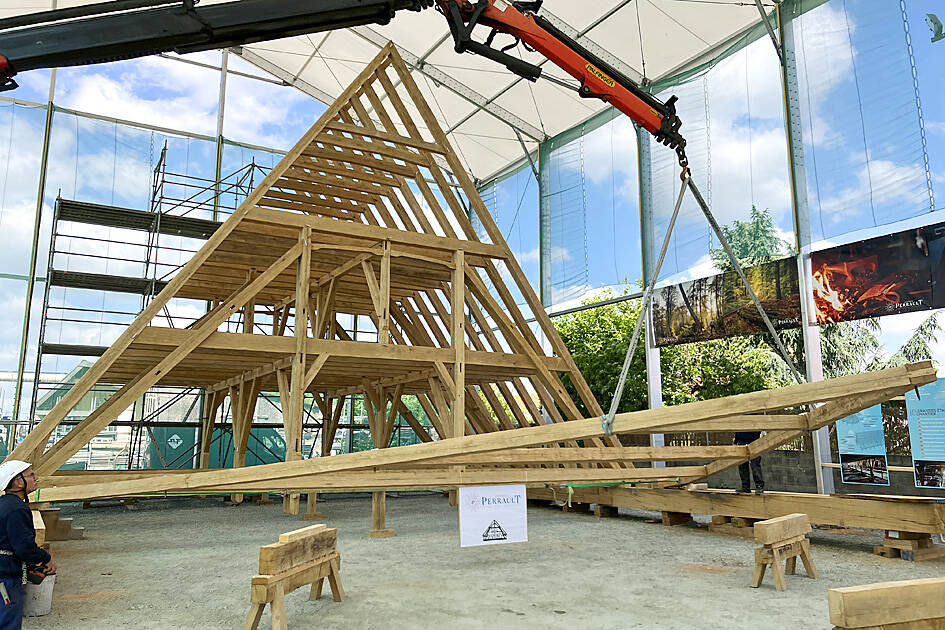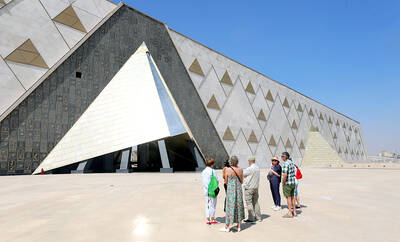If time travel was possible, medieval carpenters would surely be amazed to see how woodworking techniques they pioneered in building Notre Dame de Paris Cathedral more than 800 years ago are being used again today to rebuild the world-famous monument’s fire-ravaged roof.
Certainly the reverse is true for the modern-day carpenters using medieval-era skills. Working with hand axes to fashion hundreds of tonnes of oak beams for the framework of Notre Dame’s new roof has, for them, been like rewinding time. It has given them a new appreciation of their predecessors’ handiwork that pushed the architectural envelope back in the 13th century.
“It’s a little mind-bending sometimes,” said Peter Henrikson, one of the carpenters.

Photo: AP
He said there were times when he was whacking mallet on chisel that he found himself thinking about medieval counterparts who were cutting “basically the same joint 900 years ago.”
“It’s fascinating,” he said. “We probably are in some ways thinking the same things.”
The use of hand tools to rebuild the roof that flames turned into ashes in 2019 is a deliberate, considered choice, especially since power tools would undoubtedly have done the work more quickly. The aim is to pay tribute to the astounding craftsmanship of the cathedral’s original builders and to ensure that the centuries-old art of hand-fashioning wood lives on.
“We want to restore this cathedral as it was built in the Middle Ages,” said Jean-Louis Georgelin, a retired French army general who is overseeing the reconstruction.
“It is a way to be faithful to the [handiwork] of all the people who built all the extraordinary monuments in France,” he said.
Facing a tight deadline to reopen the cathedral by December next year, carpenters and architects are also using computer design and other modern technologies to speed the reconstruction. Computers were used in the drawing of detailed plans for carpenters, to help ensure that their hand-chiseled beams fit together perfectly.
“Traditional carpenters had a lot of that in their head,” Henrikson said. It’s “pretty amazing to think about how they did this with what they had, the tools and technology that they had at the time.”
The 61-year-old American is from Grand Marais, Minnesota. The bulk of the other artisans working on the timber frame are French.
The roof reconstruction hit an important milestone this month, when large parts of the new timber frame were assembled and erected at a workshop in the Loire Valley in western France.
The dry run assured architects that the frame is fit for purpose. The next time it is put together will be atop the cathedral. Unlike in medieval times, it will be trucked into Paris and lifted by mechanical crane into position. About 1,200 trees have been felled for the work.
“The objective we had was to restore to its original condition the wooden frame structure that disappeared during the fire of April 15, 2019,” said architect Remi Fromont, who did detailed drawings of the original frame in 2012.
The rebuilt frame “is the same wooden frame structure of the 13th century,” he said. “We have exactly the same material: oak. We have the same tools, with the same axes that were used, exactly the same tools. We have the same know-how. And soon, it will return to its same place.”
“It is a real resurrection,” he added.

With much pomp and circumstance, Cairo is today to inaugurate the long-awaited Grand Egyptian Museum (GEM), widely presented as the crowning jewel on authorities’ efforts to overhaul the country’s vital tourism industry. With a panoramic view of the Giza pyramids plateau, the museum houses thousands of artifacts spanning more than 5,000 years of Egyptian antiquity at a whopping cost of more than US$1 billion. More than two decades in the making, the ultra-modern museum anticipates 5 million visitors annually, with never-before-seen relics on display. In the run-up to the grand opening, Egyptian media and official statements have hailed the “historic moment,” describing the

‘CHILD PORNOGRAPHY’: The doll on Shein’s Web site measure about 80cm in height, and it was holding a teddy bear in a photo published by a daily newspaper France’s anti-fraud unit on Saturday said it had reported Asian e-commerce giant Shein (希音) for selling what it described as “sex dolls with a childlike appearance.” The French Directorate General for Competition, Consumer Affairs and Fraud Control (DGCCRF) said in a statement that the “description and categorization” of the items on Shein’s Web site “make it difficult to doubt the child pornography nature of the content.” Shortly after the statement, Shein announced that the dolls in question had been withdrawn from its platform and that it had launched an internal inquiry. On its Web site, Le Parisien daily published a

UNCERTAIN TOLLS: Images on social media showed small protests that escalated, with reports of police shooting live rounds as polling stations were targeted Tanzania yesterday was on lockdown with a communications blackout, a day after elections turned into violent chaos with unconfirmed reports of many dead. Tanzanian President Samia Suluhu Hassan had sought to solidify her position and silence criticism within her party in the virtually uncontested polls, with the main challengers either jailed or disqualified. In the run-up, rights groups condemned a “wave of terror” in the east African nation, which has seen a string of high-profile abductions that ramped up in the final days. A heavy security presence on Wednesday failed to deter hundreds protesting in economic hub Dar es Salaam and elsewhere, some

Flooding in Vietnam has killed at least 10 people this week as the water level of a major river near tourist landmarks reached a 60-year high, authorities said yesterday. Vietnam’s coastal provinces, home to UNESCO world heritage site Hoi An ancient town, have been pummeled by heavy rain since the weekend, with a record of up to 1.7m falling over 24 hours. At least 10 people have been killed, while eight others are missing, the Vietnamese Ministry of Natural Resources and Environment said. More than 128,000 houses in five central provinces have been inundated, with water 3m deep in some areas. People waded through